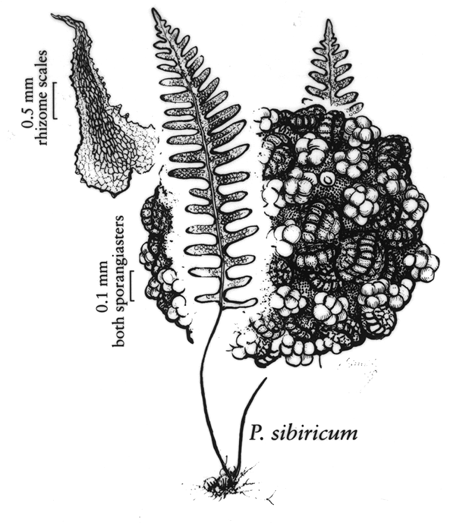|
Hardy Fern Home P. sibiricum resources
All Ferns � Polypodiaceae �� Polypodium
�Other Genera
|
| Polypodium sibiricum | ||
Polypode de Sib�rie, Multileg Siberian, Siberian polypod | ||
|
Etymology
of Siberia
Description
Rhizome: long-creeping, producing rows of fronds, occasionally branching, whitish pruinose, slender, to 6 mm diam., at the surface, scales lanceolate, brown, clathrate at the center.
Frond: 25 cm high by 4 cm wide, evergreen, last year's fronds withering as this year's appear in early summer, monomorphic, blade/stipe ratio: 2:1 to 3:1. Stipe: jointed at base, straw-colored, glabrous or scattered with thin light-brown scales, vascular bundles: 3. Blade: pinnatifid, cut almost to the rachis, oblong-linear, usually widest at or near middle, leathery, rachis sparsely scaly below, glabrous above; scales lanceolate-ovate. Pinnae: 12 to 18 pair, oblong; margins entire to crenulate; apex rounded to broadly acute; veins free, forked, obscure. Sori: round, discrete, midway between margin and midrib to nearly marginal, at vein ends; on all but the lowest pinnae of fertile fronds, indusium: absent, sporangia: yellow to brown at maturity; non-glandular paraphyses (branching structures among the sporangia) present, maturity: summer-early fall. Culture
Habitat: cracks and ledges on rock outcrops in boreal areas.
Distribution: Greenland, northern Canada, Alaska, northern Asia.
Hardy to zone 2, probably not in cultivation.
Distinctive Characteristics
Similar to P. virginianum, to which it is a parent, but smaller, paraphyses lacking glands.
Synonyms
Polypodium virginianum misapplied |
|
|
